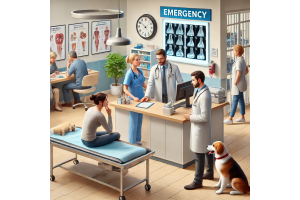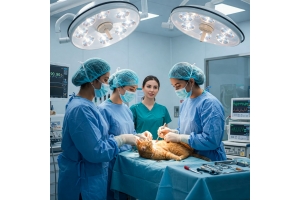Food Allergy

A food allergy is a reaction of the body’s immune system in response to particular foods or food ingredients. For unknown reasons, in a small number of dogs and cats the immune system mounts an unusually strong response to some foods.
The most common causes for both dogs and cats are proteins found in beef, chicken, dairy products, eggs, wheat, corn, or soy. In cats, fish is also a common offender. Some breeds of dogs and cats appear to be predisposed to developing food allergies, implying that there can be a genetic predisposition to food allergy. It is important to understand that food allergies develop only after the immune system has been previously “exposed” to a food. In fact, most dogs and cats have been eating a particular food for months or years before adverse reactions like allergies to it are first apparent.
Food allergies can develop in dogs and cats ranging in age from several months to any stage of adulthood. Symptoms include itchiness of the skin (pruritus), dry or crusty skin, and hair loss (alopecia). Just one area of the body may be affected, such as the paws, or itchiness and skin lesions can be spread over various regions of the body. These include the ears, face, paws, the area around the anus, armpits, and groin, and others.
Secondary infections (bacterial, yeast) of the skin can develop as a common complication of self-induced trauma of the skin. Intestinal disturbances including frequent bowel movements, loose stools, diarrhea, or vomiting occur in some cases, when the allergic process affects both the skin and the digestive system. Food allergies cause skin-related symptoms similar to those seen with several other allergies such as flea and inhalant (atopic) allergies, and for this reason, certain tests, and a dietary elimination trial, are generally needed to pinpoint food allergy and determine the right treatment to follow.
Diagnosis: Your veterinarian will perform a thorough physical exam and take a complete medical/dietary history. Be sure to list everything that your pet ingests—food and treats, but also heartworm medication, hairball treatment, feces (coprophagia), etc. It doesn’t matter if it has been consumed for years or only just recently—be sure to mention everything.
To diagnose this disorder, the suspected food ingredient or ingested substance is completely eliminated from the diet for approximately 4 to 12 weeks. During this time, your veterinarian can provide a commercially-prepared diet that is nutritionally complete. Home-prepared diets are another option. It is essential to consult with your veterinarian in order to ensure that any home-made diets contain all nutrients, to avoid serious health problems related to nutritional deficits.
Your veterinarian can discuss diet options with you. It is important that your dog or cat has never had any ingredient in the diet before and that this is the only food offered during this trial period. If your dog or cat improves while on this diet, then a food allergy is very likely the cause of the symptoms. At this time, they are “challenged” by reintroducing the ingredient or substance that had been eliminated from the diet, to be sure improvement was not just the natural course of some other skin or intestinal disorder. If symptoms worsen or return, then that ingredient/substance is considered the trigger and it must never be fed again, so as to avoid recurrent symptoms.
Living with the Diagnosis
Avoid giving the allergenic food in any amount whatsoever. Even a small amount can cause full-blown symptoms in some dogs and cats. You may need to read ingredient labels carefully before buying food and treats. All family members need to observe this rule, and if your pet is kenneled, be sure that the kennel employees are informed so they know to avoid feeding other foods or treats. If you have more than one dog or cat in the household, adherence to the specific diet may require changing the diet for all to prevent the possibility of consuming the others’ food.
Give all medications as directed and know the possible side effects.
Treatment
Antihistamines or corticosteroids may be prescribed (usually as pills/tablets) to control itching. Antibiotics or other medications help to control secondary infections when present. Special shampoos may make your dog or cat more comfortable. These are temporary solutions, and tackling the root cause of the allergy is the best way of eliminating symptoms. When the allergenic food or food ingredient is identified, it must be strictly avoided to ensure the best result.
Rarely, severe reactions to food (anaphylaxis) occur. Hives, facial swelling, and/or breathing problems result. This can be an emergency; take your pet to your veterinarian or to the local veterinary emergency clinic immediately if you see these symptoms regardless of whether food allergy has been confirmed before; anaphylaxis may occur in a dog or cat that has had longstanding food allergy in his or her medical history, or as the first sign of food allergy ever (extremely rare).
DOs
1-Provide a thorough list of all things that your dog or cat eats to your veterinarian when first evaluating the possibility of food allergy.
2-Inform your veterinarian if your dog or cat has ever been diagnosed with a medical condition and is taking medication, as these could influence the response to treatments or mask symptoms.
3-Realize that even one exposure (one nibble) of a food or treat that is allergenic can cause days or weeks of symptoms, and that strict adherence to a hypoallergenic diet is essential in pets with food allergy.
4-Give medication exactly as directed by your veterinarian, and if you are concerned about possible negative effects, discuss them with your veterinarian immediately rather than simply discontinuing the treatment.
5-Discuss with your veterinarian the possibility of a second opinion from a veterinarian specialized in skin disorders (veterinary dermatologist; www.acvd.org ) if the problem is persistent, severe, or complicated.
DON’Ts
1-Do not give any other foods (including treats, chewable medications like heartworm preventative flavor cubes, etc.) than the one selected by your veterinarian when you are feeding the hypoallergenic food.
2-Do not give medication that you have at home that has been prescribed for human use; some of these may interfere with treatment or cause even more severe problems.
When to Call Your Veterinarian
1-If your dog or cat will not eat the trial diet—cats that don’t eat for more than 24 hours can develop liver problems that must be avoided.
2-If you cannot keep a scheduled appointment.
3-If you are unable to give medication as directed.
Signs to Watch For
As indicators of general health, especially if taking medications:
Watch for general signs of illness, which include vomiting, diarrhea, decreased appetite, weight changes, and changes in behavior such as hiding more than usual and aggressiveness.
Specifically if suspecting food allergy, or when food allergy has been confirmed in the past and as a sign of recurrence:
Watch for signs of food allergies, which include itching, redness, crusts or scales on the skin, frequent bowel movements, loose stools, vomiting, and diarrhea.
Routine Follow-Up
Follow-up appointments are scheduled during the food trial and subsequent challenge to monitor progress.
Additional Information
Although one food or food ingredient may be identified as an allergen, allergies to other foods can develop later in life. See your veterinarian if symptoms return.






